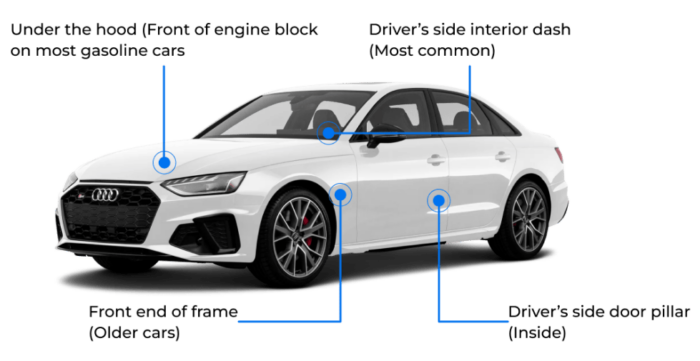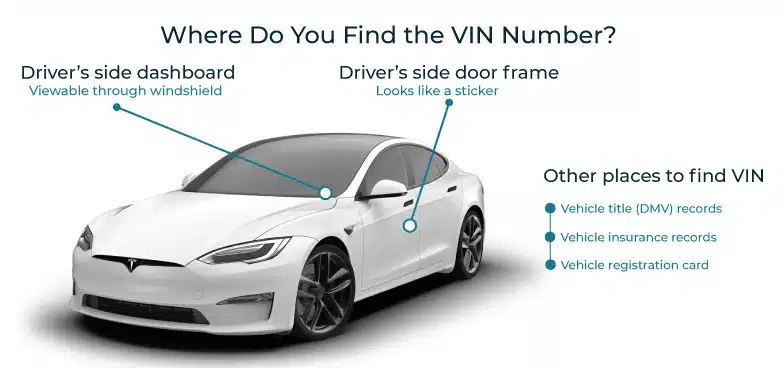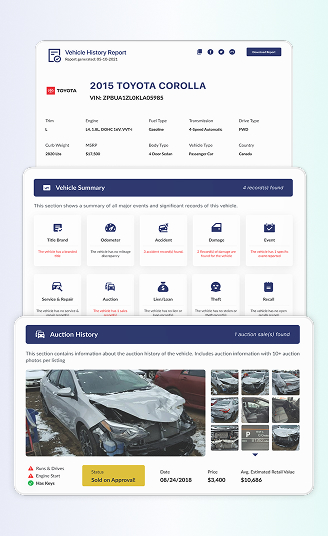Free VIN Lookup | Check Your Engine Type by VIN
Knowing the vehicle’s year, make, and model is easy, but what if you need to know the engine details? With just the VIN, you can be informed about the engine type of any vehicle. Use our engine type by VIN tool and get details of your vehicle’s engine, like the type, size, and capacity
How do you know the right engine type and size of a vehicle? You don’t, unless you decode the VIN. If you want to know the engine type of any vehicle, you only need a VIN and you can use our VIN decoder. Know engine type, engine size and more engine specs in a few. Decode any VIN for free now!
What Is a VIN and Why Does It Matter for Engine Info
The Vehicle Identification Number or VIN is a 17-digit code that consists of numbers and letters and is usually used to identify a certain vehicle, even though the unit has the same year, make, model, and trim.
The VIN number is not a random sequence of numbers and letters; rather, each of them represents all the detailed information of the vehicle, like the manufacturer plant location, country of origin, and the engine specifications, which is usually placed on the 8th digit.
While many manufacturers designate the engine type exclusively in the eighth digit, others may disperse option codes across the 4 to 7th digits, or utilize a different digit for certain models. To find the exact vehicle’s engine information, you can use the engine type by VIN service or a VIN Decoder.
Where Can I Find My VIN Number?
You can find the VIN on the vehicle’s body and paperwork, like registration or insurance. Here’s where you can find the VIN.
Driver’s side door jamb
Dashboard of the vehicle, just below the windshield
Under the hood
Registration documents
Insurance documents
Certificate of title

How to find Engine Type by VIN?
To look up the engine type by VIN, you just need to click on the form above and follow these simple steps
Find the VIN
You will need to find the VIN before you check the engine by VIN. Check the section above, check the VIN.
Fill in the Form
Click on the form above, then write down the VIN. After that, click on the button to submit the VIN.
Get the Report
Wait for seconds for the report to be generated. Once the report is generated, you may also purchase the window sticker to examine the vehicle’s engine type better.
How to Read a VIN Number?
A Vehicle Identification Number (VIN) is a 17-character combination of letters and numbers that reveals key details about a vehicle. Here’s a simple breakdown of what each section means:
World Manufacturer Identifier
First 3 Characters
- Position 1: Shows where the vehicle was manufactured (for example, “1” represents the USA).
- Positions 2–3: Identify the vehicle’s manufacturer (for example, “F” for Ford).
Vehicle Descriptor Section
Positions 4–9
- Positions 4–8: Provide details about the vehicle’s brand, body style, engine size, and type (for example, “GHDLZ”).
- Position 9: Represents the check digit, which is used to verify the VIN’s authenticity.
Vehicle Identifier Section
Positions 10–17
- Position 10: Indicates the vehicle’s model year.
- Position 11: Identifies the assembly plant where the vehicle was built.
- Positions 12–17: Represent the vehicle’s serial or production number.
Types of Car Engines
The car engine can be categorised into several categories. by cylinder arrangement, number of cylinders, fuel type, and fuel injection method. Understanding these types helps explain how engines differ in performance, efficiency, and driving feel.
Cylinder Arrangement
The layout of cylinders inside an engine plays a big role in how smoothly the car runs and how much space the engine takes up.
Straight Engine (or Inline-Straight Engine)
In a straight engine, all cylinders are placed in a single line, parallel to the car’s length. This design is simple and balanced, often used in sedans and luxury cars for smooth performance.
Inline Engine
The most common layout today, especially for small family cars and hatchbacks. Cylinders are arranged in a row but positioned perpendicularly to the car’s direction. This setup saves space under the hood, allowing room for components like the radiator, battery, and cooling system.
V Engine
Cylinders are placed in two banks set at an angle, forming a “V” shape when viewed from the front. The compact design allows for more cylinders without increasing the engine’s length. V engines are commonly found in sports cars and high-performance models due to their power and smooth operation.
Flat (Boxer) Engine
The flat engine cylinders lie horizontally in two opposing rows, facing away from each other. This lowers the car’s centre of gravity, improving balance and cornering. Although rare, this type is popular in brands like Porsche and Subaru for sports-oriented performance.
Number of Cylinders
The number of cylinders determines how powerful the engine is and how smooth it can be; more cylinders usually mean higher power and faster acceleration.
- Twin-Cylinder Engines: Small and light but not very powerful. These are rarely used today except in compact city cars or motorcycles.
- Three-Cylinder Engines: Found in small cars that prioritise fuel efficiency. Turbocharged versions can offer surprisingly strong performance.
- Four-Cylinder Engines: The most common type, balancing power, fuel economy, and size. Used in most small to mid-sized vehicles.
- Five-Cylinder Engines: Less common, but they offer the smoothness of a six-cylinder engine while remaining compact.
- Six- and Eight-Cylinder Engines: Used in high-performance, luxury, or sports cars. They deliver excellent power and speed but consume more fuel.
Cylinder Arrangement
Engines can also be classified based on the type of fuel they use:
Gasoline Engines
Use petrol (gasoline) and are known for quieter operation and lower vibration. However, they typically have lower fuel efficiency than diesel engines.
Diesel Engines
The diesel engine offers better fuel economy and torque, making it ideal for heavy-duty vehicles. They’re louder but more durable and cost-effective in the long run.
LPG Engines
Run on liquefied petroleum gas, producing less noise and lower fuel costs. However, they have limited availability and come with safety risks due to gas storage.
Cylinder Arrangement
The method of injecting fuel into the combustion chamber affects engine efficiency and performance.
GDI (Gasoline Direct Injection)
Used in modern gasoline engines. Fuel is sprayed directly into the combustion chamber, increasing efficiency and power output. The downside is higher cost and more noise compared to other systems.
MPI (Multi-Point Injection)
Each cylinder has its own injector that sprays fuel into the intake manifold. It’s less powerful and efficient than GDI but quieter, cheaper, and more durable.
CRDI (Common Rail Direct Injection)
Found in diesel engines. It delivers precise amounts of fuel under high pressure, resulting in cleaner combustion, higher power, and lower emissions.
Why Engine Details Are Important?
Knowing the vehicle’s engine details is important because the engine is the heart of every vehicle. As an owner, it’s important to know the engine’s details to understand its performance, maintenance, fuel efficiency, and even resale value.
To Check If the Car is Real
Engine details can help you know if a car still has its original engine or if it was changed before. When buying a used car, this is important to make sure the vehicle is not fake or damaged. Matching the engine number with the VIN helps prove that the car is real and honest.
To Know the Car’s Power and Fuel Use
The engine type and size affect how strong the car is and how much fuel it uses.
- Four-cylinder engines are simple and good for daily use.
- Six- or eight-cylinder engines are stronger and often used in sports or heavy vehicles.
By knowing the engine details, buyers can choose a car that fits their driving habits and fuel budget.
To Help with Repairs and Maintenance
When fixing or servicing a car, mechanics need to know the correct engine type, because they need to find the right parts and tools. Without the right engine details, repairs can take longer and cost more money.
For Registration and Legal Use
Engine information is often needed for car registration, insurance, or emissions tests. If the engine number does not match the VIN, it can cause problems with ownership or legal documents.
To Make Buying and Selling Safer
Knowing how to check engine type by VIN helps build trust between buyers and sellers. It shows that the car’s details are open and clear, helping both sides feel safe about the vehicle’s transaction.
Example: Engine type by VIN
VIN: JHMES966X4S012004
Decoded Engine Info:
Engine displacement: 1.3L
Number of cylinders: 4
Camshaft: SOHC
Number of valves: 8
Hybrid engine
Fuel type: Gasoline
Transmission: Automatic CVT Overdrive

Popular Car Models and Their Engine Types and Sizes
- Car Model
- Toyota Corolla
- Honda Civic
- Ford Mustang
- Volkswagen Golf GTI
- BMW 3 Series
- Mercedes-Benz C-Class
- Subaru Impreza WRX
- Chevrolet Camaro
- Porsche 911
- Tesla Model 3
- Engine Type
- Inline-four (L4)
- Inline-four (L4)
- V6 or V8
- Inline-four (L4)
- Inline-four or Inline-six
- Inline-four or V6
- Flat-four (Boxer)
- V6 or V8
- Flat-six (Boxer)
- Electric
- Engine Size (Displacement)
- 1.8L
- 2.0L
- 3.7L (V6) or 5.0L (V8)
- 2.0L
- 2.0L (L4) or 3.0L (L6)
- 2.0L (L4) or 3.0L (V6)
- 2.0L
- 3.6L (V6) or 6.2L (V8)
- 3.0L (911 Carrera)
- N/A (Battery-powered)
FAQ About engine type by VIN
Yes, you can find the car’s engine size by using an online VIN lookup tool like the Detailed Vehicle History. You just need to enter the VIN on the form to get a report that will show you the vehicle’s engine specifications.
Yes, a vehicle’s VIN can tell you what engine it has because specific characters within the 17-digit code provide details about the engine’s size and type. To find this information easily, you should use an online VIN decoder tool like the Detailed Vehicle History.
You can find your car’s engine model by using an online VIN decoder and entering your 17-character VIN on the form above.. The engine type is often included in the 8th digit of the VIN, but some manufacturers might use other positions between the fourth and ninth characters.
A VIN contains 17 characters that specify a vehicle’s unique information, detailing its country of origin, manufacturer, model year, assembly plant, and unique serial number.
The first three digits identify the manufacturer and country, the next six describe the vehicle’s features, such as engine and body style, and the final eight identify the model year, factory, and serial number.
The 8th digit in a VIN (Vehicle Identification Number) usually shows the vehicle’s engine type, although its exact meaning can change depending on the manufacturer. This information is vital for correctly identifying replacement parts, especially for the engine or its components, and for making sure the vehicle follows emissions regulations.


